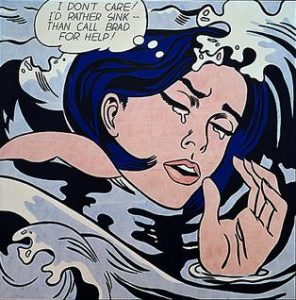
Roy Fox Lichtenstein, a New Yorker, was a key figure in the Pop Art movement in the 1960s. Alongside other big pop art figures, such as Jasper Johns, James Rosenquist and of course, Andy Warhol, Lichtenstein became a leading figure of this time. His work branched off of the go-to pop art route and went down the parody lane. He was inspired by comic strips, cartoons and advertisements back in the day. He often used a tongue-in-cheek manner in his pieces, which is very relatable. A larger-scale work, Look Mickey, was inspired by a challenge one of his sons gave. Lichtenstein’s son pointed at a Mickey Mouse comic book and said; “I bet you can’t paint as good as that, eh, Dad?” And boy oh boy did dad take up the challenge. He not only took up painting Look Mickey, but he also produced six other works with recognizable characters.


I love that Lichtenstein could have fun with his pieces and create something he enjoyed out of it. I tend to do that in my work, but have been told it is “unprofessional.” This mindset of taking on a challenge to prove someone wrong is honestly super inspiring. Though proving someone wrong is not always the key goal, it’s nice to show that you can go above and beyond the expectations.

As well as the dares that his son would throw at him, Lichtenstein found his groove for proto pop art while teaching at Rutgers University. The environment helped to ignite his interest in the cartoonesque style. His works throughout the years were further inspired by comic books, especially those that featured war and romance. He honestly had an interest in anything that was emotionally strong in the subject matter.
His techniques used are hard lines and ben-day dots. These funky little dots were used way back in 1879 and were a printing /photoengraving technique, which can be seen in a lot of his pieces.

Overall, I have been inspired by Roy Lichtenstein’s work for most of my life. I love the comic style and the pop art movement as a whole, so seeing big artists be goofy with it is relieving. It shows that it’s okay to be me, goof and all.
Citations
https://en.wikipedia.org/wiki/Roy_Lichtenstein
https://www.moma.org/artists/3542
https://www.britannica.com/biography/Roy-Lichtenstein
December 5, 2020 at 7:43 pm
Chloe,
Excellent posts on both Klee and Lichtenstein! Your information and background on the artists dovetails wonderfully with your copious personal thoughts and feelings for the works in question. Also your enthusiasm for your studies shines through in all you’ve done in this class. Keep this up moving forward.
Jeff
December 16, 2020 at 7:57 pm
Chloe,
I’ve made the corrections to the final quiz and your score was 43/50 which translates to an A! Great work and attitude this term and just keep moving forward. Hope you and your family have a great holiday break.
Jeff